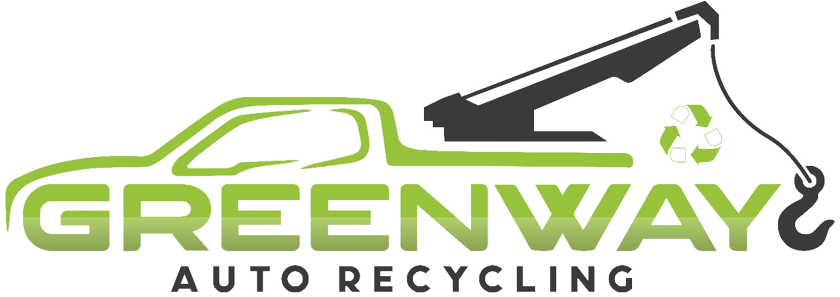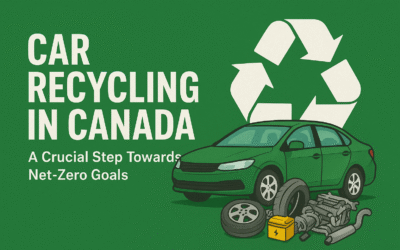Introduction
Ever wondered how a car in Ontario, no longer fit for the road, ends up contributing to markets halfway around the world? A vehicle might finish its active life in Canada, but the story doesn’t stop there. From dismantling to shipping, parts and metals flow from Canadian scrapyards into global auto markets.
That journey links local operations to far‑flung regions, shaping trade, sustainability, and supply chains. Let’s examine how this network functions, its significance, and how it integrates within the global auto recycling ecosystem.
1. The Starting Point: Vehicle End‑of‑Life in Canada
After a car or light truck becomes uneconomical to repair or fails inspection, it is sent to a scrapyard for disposal. In Canada, the process is governed by provincial and federal rules on the disposal of end‑of‑life vehicles (ELVs).
At the yard, the vehicle is drained of fluids, hazardous components are removed (such as batteries, airbags, and refrigerants), and then parts are salvaged. This salvage stage is pivotal. Not only do Canadian yards recover steel, aluminum, and other metals, but they also identify reusable components—such as engines, transmissions, and body panels—that might serve further life.
This sets the foundation for linking to global markets: Canada’s infrastructure for dismantling and component recovery enables the flow of high‑quality material and parts beyond domestic borders.
2. From Local Salvage to International Trade
Once parts and metals are sorted, Canadian scrapyards and recyclers either supply local markets or prepare them for export to international markets. For metals, Canada’s recycling market is showing steady growth, particularly driven by demand in the automotive and construction sectors.
When it comes to auto parts specifically, global buyers look for high-quality, compatible components and reliable logistics. For example, one Canadian auto recycler tracks and tests parts, bundles them, and ships them overseas to markets in Africa, South Asia, and the Middle East.
Thus, the link is: Canadian end‑of‑life vehicle processing → salvage of reusable parts/metals → export logistics → global markets. The entire chain depends on export rules, transport networks, and quality assurance.
3. What Makes Canadian Scrap Yards Attractive to Global Buyers
Why do international buyers engage with Canadian recycling yards rather than only local sources? Here are some key reasons:
- In Canada, vehicles are often subject to strict safety and emissions standards. That tends to mean better‑maintained components.
- Canadian climate demands durability (cold starts, winter conditions), so engines/transmissions may be robust even after years of use.
- Many global markets run older fleets and face high costs for new parts, making used components from Canada an affordable solution.
- Established export logistics and familiarity with cross‑border trade help Canadian yards manage international buyers and shipping.
Due to these factors, Canadian scrap yards have become integral to a global supply chain, rather than merely local salvage operations.
4. The Role of Metals Recycling in the Supply Chain
Beyond parts, the scrap metal stream from vehicles is critical. Steel, aluminum, copper, and other metals recovered from end‑of‑life vehicles feed into domestic and global metal markets. The Canadian scrap metal recycling market is forecast to grow at a rate of around 2.2% CAGR through 2031, driven in part by the automotive sector.
For example, one Canadian firm processes millions of pounds of scrap steel, aluminum, and brass each year and prepares it for export to global markets.
In this way, Canadian yards serve as nodes that convert vehicles into raw material (metals) and semi-finished goods (used parts), which then flow into global manufacturing or repair supply chains.
Also Read: How Non-Metallic Car Parts Are Recycled and Repurposed for a Greener Future
5. Regulations, Standards, and Export Logistics
Connecting to global markets requires navigating several regulatory requirements. Exporting used car parts and scrap from Canada involves import‑export classifications, customs paperwork, origin documentation, and compliance with environmental laws. According to industry commentary, the global auto recycling sector is shifting from informal “scrapyards” to certified end‑of‑life‑vehicle (ELV) processing centres, with more rigorous environmental and tracking standards.
Within Canada, vehicle scrappage policy analysis reveals that the federal and provincial governments are tracking and regulating the removal of older vehicles.
In practical terms, this means that Canadian yards exporting parts must inspect, document the condition, accurately classify items, and ensure that packaging and shipping meet the required standards. Global buyers require traceability and quality assurances. This regulatory framework helps link yard operations seamlessly into global trade.
6. Global Demand Patterns and Where Canadian Outputs Go
The demand for used parts and recycled metals varies by region. In developing markets, many older vehicles are still in operation and getting repaired rather than replaced. That creates demand for good used parts. The blog from a Canadian yard notes shipments of engines, transmissions, and axles from Canada to Africa, South Asia, and the Middle East.
On the metals side, recycled steel and aluminum are exported to global commodity markets and used in manufacturing in other countries. It means that Canadian scrap yards serve as entry points into global resource flows.
Therefore, if you consider global auto markets—both for repair parts and raw materials—Canadian yards serve as supply nodes connected to international networks.
7. Benefits and Challenges of the Global Connection
Benefits:
- Extending the useful life of vehicle components avoids waste. Parts shipped from Canada to overseas help keep vehicles running and reduce pressure for new manufacturing.
- Recycled metals reduce demand for virgin materials, cut mining, and lower emissions.
- Exporting enhances the value of Canadian recycling operations, supporting job creation and business growth.
Challenges:
- Price volatility in metals and shipping costs can squeeze margins. For example, the Canadian scrap metal sector is heavily influenced by global pricing.
- Logistics from Canada to overseas markets involve transport, customs, export paperwork, liability for condition, and compliance.
- Buyers overseas must trust that parts meet specifications and will work reliably; that places a burden on Canadian yards to test, label, and document.
- Exporting used vehicles or parts to countries with lax regulatory frameworks may create unintended consequences. The global auto‑recycling article warns about this.
8. What This Means for Ontario and Canadian Auto Recycling Businesses
For businesses in Ontario and across Canada, linking to global auto markets opens a growth path. By specializing in high-quality parts, adhering to rigorous dismantling practices, ensuring export readiness, and establishing robust logistics, Canadian yards move beyond local scrap to play key roles in the international supply chain.
In Ontario, especially, where vehicle volumes are high and end-of-life cars are plentiful, recycling yards can develop export capabilities, gain a competitive advantage, and tap into global demand.
It also means staying ahead of regulation, investing in part tracking, condition testing, and export packaging. In short, to connect globally, the local process must meet global standards.
9. Future Outlook: Trends to Watch
Looking ahead, several trends will shape how Canada’s scrap yards link to global auto markets:
- Growth of the vehicle recycling market globally (projected to rise from USD 81.2 billion in 2022 to USD 143.6 billion by 2027) suggests expanding opportunities.
- Rising environmental regulations and circular economy policies will prompt dealers and recyclers to prioritize reuse over disposal.
- Technological improvements (inventory management, VIN tracking, condition grading) will enhance cross‑border part trade.
- The shift to electric vehicles (EVs) will alter the composition of end-of-life vehicles and the types of parts and metals recovered, opening new global markets for battery components and rare metals.
Conclusion
Canadian scrap yards play a vital role in global auto markets by dismantling vehicles, salvaging parts, and supplying metals and components to the automotive industry worldwide. For car owners in Ontario, using a trusted service for scrap car removal ensures vehicles are handled responsibly while parts and materials reach international buyers.
Greenway Auto Recycling provides reliable scrap car removal, accurate documentation, and secure handling of license plates, connecting local vehicles to global reuse opportunities and promoting sustainable recycling practices nationwide.





